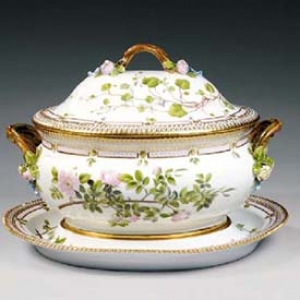
 Online Shop You don't have products
Online Shop You don't have products in your cart

In 1600 the Portuguese and Dutch companies who traveled between Europe and Asia brought back to Europe ships loaded with silk, gold and porcelain.
Discovered in China the origin of porcelain has been surrounded by mystery. People were fascinated by its whiteness, and its transparency. Even its sound was something totally new. With all these virtues is not surprising that porcelain displaced in time clay, wood and metals that during centuries had been the material support of every day dinner services.
Manufacture techniques were exceptional and all the West was searching for the recipe of Porcelain. The Emperor Kangsi (1654-1722) saw in this material a business opportunity. The priority during his reign was to organize pottery industry to focus on the activity of export (given the demand of countries in the West.)
For this he rehabilitated the Jingdezhen city were he set up factories and buildings. The city contained more than 3.500 kilns and 1 million citizens who worked in the pottery industry.
Emperor Kangsi took care of the secret of the elaboration of the earthware and search a way of production that guaranteed the mystery. He ordered his workers to be specialized. Each one had an industrial task and this way nobody had the hall story to produce the material that was manufactured.
Those precious objects were soon to become object of desire, it was urgent to discover the formula and only China new the secret of its manufacture.
To cross Asian continent had its dangers and shipwrecks were frequent. One of their most famous was the Geldermalsen from The Dutch Company of the Indies. It Sunk in 1752 was discovered until 1985 by Captain Hatcher in the China sea. More than 150.000 pieces were found. Most of those pieces were given to the Groningen Museum to be studied and the rest were auctioned off at Christies in 1985.
The shipments of the valuable white gold that were arriving in Europe from China captivated soon continental Aristocracy. Several European monarchs allocated important materials resources to discover the secret of porcelain jealously kept the Chinese people until at the beginning of XVIII century in the court of the Elector of Saxony when the composition and firing methods were discovered by Böttger.
To the triumph of research work was soon added the process of industrial development in Saxony with the creation of the Meissen Factory.
During the XVIII century emerged new porcelain factories in France, Austria, Denmark Italy and Spain which produced pieces more and more refine. Along with Meissen emerged important porcelain manufacturers. In the XIX century Herend from Hungary joined all these factories with the same goal to produce fine and beautiful porcelain.
Porcelain has universally become a material suitable enough to cover totally excellency all domestic needs related to the art of the table, and it was produced at all levels. To have a porcelain dinner service is no longer a luxury of a few. In the market exist a great variety of possibilities that go from modest white dinner services to a very sophisticated like the Flora Danica from Danemark. This is a botanical encyclopedia from the XVIII century and is linked to the Royal Family. The first Flora Danica dinner service was ordered by King Christian VII as a diplomatic reconciliation gift for Catherine the Great Empress of Russia. Nowadays it is a wedding present from Scandinavian monarchs when a Prince is going to get married.
Another example is the Natural History of Buffon. All sort of exotics and beautiful birds decorate a fabulous Sevres dinner service exposed at the Museum Nissim de Camondo in Paris.
To this day a lovely porcelain dinner service is a value that does not go out of fashion. In fact it is something to be passed down from generation to generation.

